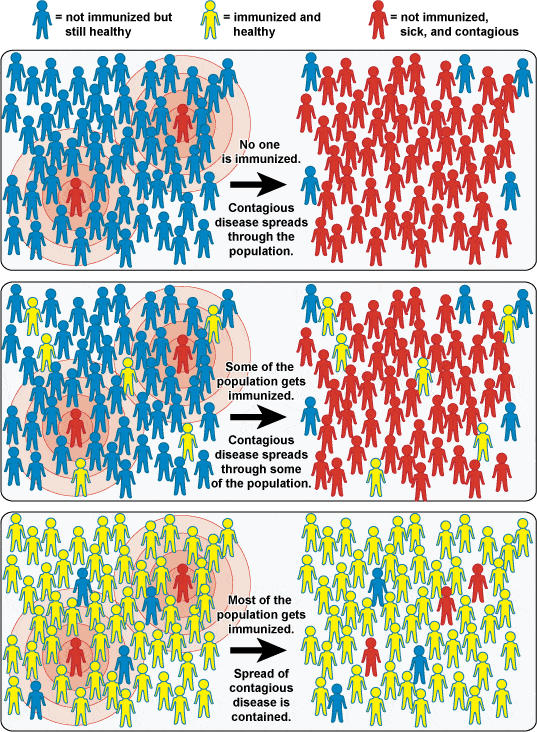More than 21 million hospitalizations and 732,000 deaths among children born in the last 20 years have been spared by vaccination preventive action, but despite this more and more parents choose to shun vaccines, not only for them, but for their children as well. The consequences are evident, but it’s not the lives of themselves and their children that parents who refuse vaccines risk. It’s that of those around them, in their communities as well. If anti-vaccination parents were distributed randomly in communities, this wouldn’t be that much of a big deal. However, a new study suggests those who refuse vaccines tend to cluster and live in the same communities, in larger proportions than elsewhere. Doctors believe this anti-vaccine herding could have serious consequences for public health.
There’s no vaccine against folly
Dr. Tracy Lieu, director of Kaiser’s Division of Research, and colleagues analyzed the medical records of 155,000 children who lived in 13 Northern California counties and were born between 2000 and 2011. They focused on children that had received no vaccines, as well as those that were under-immunized (had missed a shot or more before they turned three). Across the 13 counties analyzed, the proportion of children who’d missed one or more shots increased from an average of 8 percent at the beginning of the study period to 12.4 percent at the end, suggesting that the anti-vaccine campaigns had taken off and influenced the decisions of many parents. However, the researchers also wanted to see which communities had a higher vaccine refusal rate.
[ALSO SEE] Vaccination starts with pregnancy, for everybody’s health
When the researchers drilled down to the county level, they found pockets of even higher rates of under-immunization, ranging from 9.2 percent in Santa Clara County to 17.9 percent in Marin County between 2010 and 2012. Five hot spots particularly stood out, with the most threatening being a a 1.8-mile area in Vallejo, where 22.7 percent of kids were under-vaccinated. In total, more than 10,000 children live in these five hot spots.
Even more disheartening is the identification of five hot spots where vaccines were completely missing.
- 10.2 percent of children in an area from El Cerrito to Alameda
- 7.4 percent in northeastern San Francisco
- 6.6 percent in Marin and southwest Sonoma counties
- 5.5 percent in northeastern Sacramento County and Roseville
- 13.5 percent of kids in a small area south of Sacramento
So, there are quite a communities where even one in ten kids haven’t been vaccinated at all! That’s 9,000 children, according to the study published in the journal Pediatrics.
“These are early signals,” says Lieu. “These kinds of clusters can be associated with later epidemics.”
Last year, when a record number of California parents claimed personal belief exemptions, health officials reported the most measles cases seen here since 1995 and the most whooping cough cases since 1947.Marin, Napa and Sonoma counties — where Lieu and her team found under-immunization clusters ranging from 17.5 to 18.1 percent — had the highest rates of whooping cough in the state in 2014.
When a critical portion of a community is immunized against a contagious disease, most members of the community are protected against that disease because there is little opportunity for an outbreak. Even those who are not eligible for certain vaccines—such as infants, pregnant women, or immunocompromised individuals—get some protection because the spread of contagious disease is contained. This is known as “community immunity.”

The reverse is true, too – past a threshold, if not enough people are immunized, the herd immunity is lost and people are at risk of contacting diseases. Even those who were immunized. Vaccines do not immunize 100%, so even children who are vaccinated can in some cases catch diseases from children that haven’t been. That’s why states require children to be fully vaccinated before entering kindergarten.
Parents disregard vaccines because of a notoriously flawed studies that had linked vaccines with autism in children. This was long-ago proven wrong and actually exposed as an elaborate fraud paid for by a group that wanted to sue vaccine manufacturers. It’s effects linger on, and by the looks of it the ripples have only gone bigger. It’s a disaster!
Just about every medical professional agrees that refusing vaccines is a stark threat to public health, but in a country where individual rights are cherished, creating a set of rules that will protect those that choose to vaccinate, as well as those who do not can be very difficult.
“We’re open-minded in the U.S.,” says Dr. Paul Offit, who directs the Vaccine Education Center at Children’s Hospital of Philadelphia and was not associated with the study, “even to the point where we let parents hurt their children.”
According to NPR:
Not long ago, a one-and-a-half-year-old boy was admitted to Offit’s hospital. He’d been seen at the hospital’s outpatient clinic at two, four, six and 12 months — all the times when kids get the pneumococcal vaccine. But his parents chose not to vaccinate and the staff didn’t push it, Offit says. “He came in with pneumococcal meningitis,” and then suffered a devastating brain herniation, Offit said. “He will never see, walk or speak again and probably won’t live past five. It’s not OK.”


